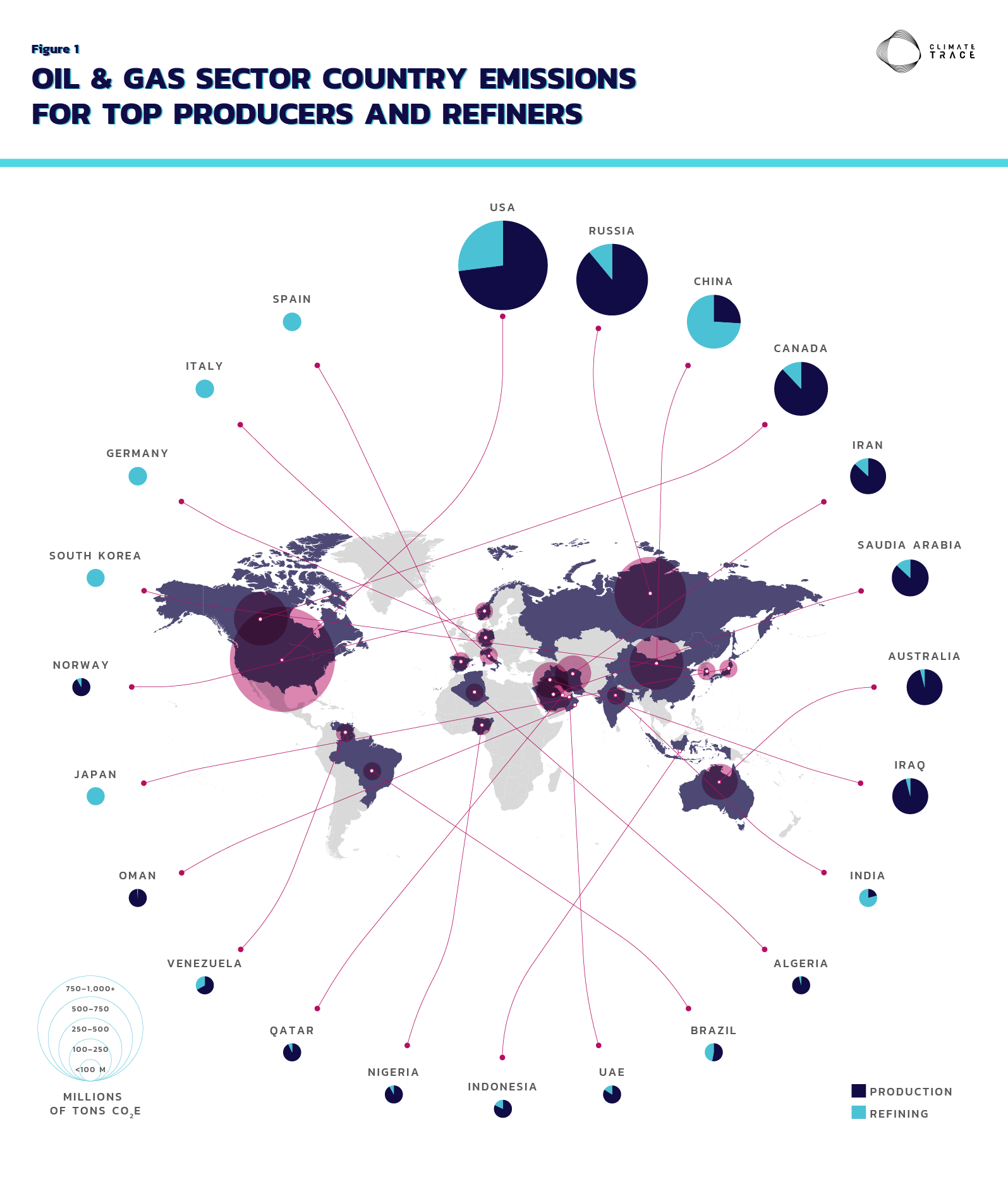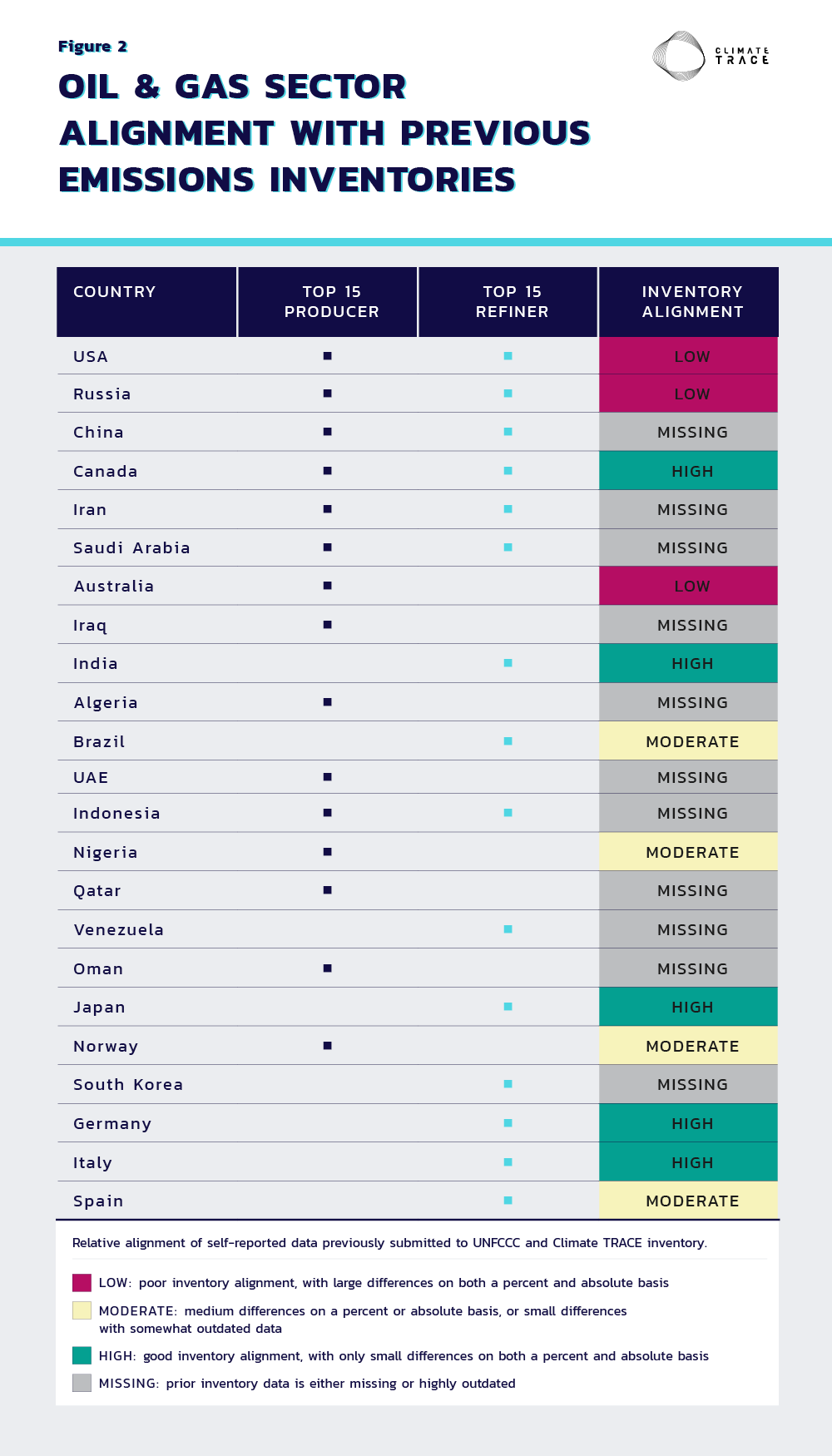Gas or flare burn on offshore platform. Offshore construction platform for production oil and gas,Oil and gas industry

Climate TRACE Lifts the Veil on Oil and Gas Emissions
When it comes to climate, oil and gas are the 800-pound gorilla in the room. The production and refining processes for oil and gas account for about one-tenth of human-made greenhouse gases (GHGs), making the sector one of the world’s largest emitters. But it is far less clear where in the world these emissions actually come from, which parts of the supply chain are responsible for them, and how much they shift over time. This climate-critical sector has historically been too opaque, making it difficult to create credible climate pledges and nearly impossible to take immediate and meaningful action to mitigate emissions.
However, with today’s launch of Climate TRACE, we are a step closer to having clearer answers about the origins and amounts of GHGs in the atmosphere. Climate TRACE is the world’s first comprehensive accounting of global GHGs based primarily on direct, independent observation. It was named by TIME magazine as one of the 100 best inventions of 2020 and now, we are excited to share why.
Driven by satellites, remote sensing, and advanced applications of artificial intelligence and machine learning, Climate TRACE identifies when and where greenhouse gases are emitted. This enables leaders to pinpoint and prioritize specific decarbonization efforts to yield the greatest reductions. This level of focus is critical, as we have just nine years to halve emissions and stay on track to hold global temperature rise to 1.5°C.
Informing Effective Climate Action
The intelligence gathered from Climate TRACE fills critical knowledge gaps for all countries that rely on the patchwork system of country self-reporting. This self-reported data serves as the basis for most existing emissions inventories, such as the country-level emissions data submitted under the United Nations Framework Convention on Climate Change (UNFCCC). The intelligence collected by TRACE is particularly relevant to the more than 100 countries that currently lack access to comprehensive, recent emissions data.
RMI is a proud member of the TRACE coalition and has been particularly focused on helping to make emissions from the global oil and gas sector visible, starting at the country level. Our latest analysis reveals several key insights that can help policymakers identify the right actions to pursue today.
In both production and refining, the top 15 countries in each category account for over 70 percent of emissions.
The path to global decarbonization starts with knowing where emissions come from. Just 15 top production countries and 15 top refining countries account for the lion’s share of oil and gas sector emissions. Several countries, including the United States and Russia, pollute doubly, emitting massive amounts of GHGs from both oil and gas production and refining. Others are top emitters in terms of production or refining, but not both, as shown in the two figures below.
Each country can focus its GHG reduction strategies on where it emits most (production, refining, or both). This will be critical when it comes to tracing and reducing emissions from petroleum supply chains.
Self-reporting today is wholly inadequate—many top oil and gas emitters don’t even track their emissions.
Overall, emissions from the large, intensive oil and gas sector are poorly accounted for. Among the world’s top countries that submit regular GHG inventories, emissions from oil and gas production and refining may collectively be around double the amount in recent UNFCCC reports. Further, it is likely that over 1 billion additional tons of CO2 equivalent per year—more than the annual emissions of the 100 lowest-emitting countries combined—have gone uncounted by nations that aren’t required to report their oil and gas emissions regularly.
This is, in part, a result of haphazard accounting and convoluted reporting in current inventories. For example, several high-emitting oil and gas operations, such as surface processing, hydrogen production, and catalyst regeneration, are not reported uniformly in country inventories. This leads to missing or hidden emissions.
Furthermore, reporting requirements vary among different countries due to historic UNFCCC designations, resulting in inadequate country assessments of global oil and gas emissions. Some countries (designated as “Annex 1” nations) typically submit regular inventories on a two-year delay. Other countries (non-Annex 1) are not subject to the same guidelines and don’t report regularly. This hodgepodge approach makes it difficult to carefully track emissions trajectories and obtain up-to-date information to make informed climate decisions.
Of the top countries for global oil and gas production and refining, fewer than half are required to regularly inventory and report sector-specific emissions (see Figure 2).
Drilling down to the level of oil and gas assets and operations reveals further opportunities to reduce emissions.
While quantifying and differentiating country-level emissions is critical, expanding transparency beyond national data reveals new opportunities to slash GHG emissions. Even within a country, the climate intensity of oil and gas can vary markedly. In the United States, for example, a barrel of heavy oil from California can be 10 times dirtier than a barrel of low-leak light oil from Texas. The same holds true for gas production and oil refining. But this emissions gap can be significantly narrowed through available operational improvements.
Greater visibility on oil and gas assets and operations offers insights that countries can use to submit more accurate emissions inventories and climate pledges. As the granularity of TRACE data improves over time, decision makers will be able to pinpoint emissions from specific sites and operations, both in the oil and gas industry and in other high-emitting sectors. With this climate intelligence, we can quickly cut oil and gas sector emissions as we strive to meet global climate and sustainable development goals.
Bringing Transparency to COP26
To chart a clean energy transition, we must bring transparency to emissions-intensive sectors like oil and gas. For production and refining, the Climate TRACE platform bolsters accountability that is currently lacking when countries self-report their emissions. The platform also offers all countries access to reliable, accurate, and timely emissions data across all sectors of their economies.
This data is especially important as world leaders head into climate negotiations at the UN Climate Change Conference (COP26) in November. With the launch of Climate TRACE, every country’s leaders can now inform their decisions with data that reflects current emissions trends, rather than outdated or incomplete estimates. Bringing transparency to emissions will be critical to prioritizing the most meaningful, timely solutions—after all, we have no time to waste.
Learn More and Get Involved
We encourage you to dig deeper into the TRACE tool, and we call on data providers to join our coalition to help drive continuous improvements and provide more granularity.
Learn more at https://www.climatetrace.org/.

